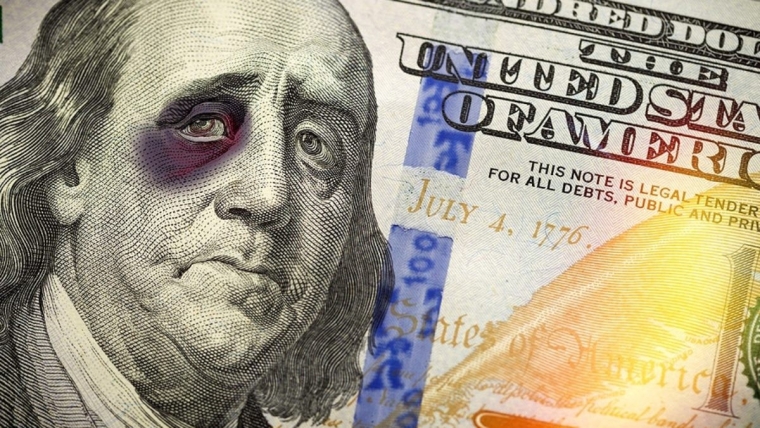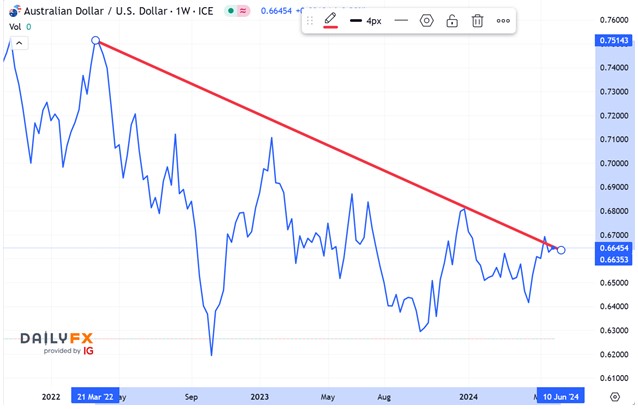
Summary of key points: -
- US dollar to weaken further on softer data
- Europeans in a tizz on interest rate cuts
- Australian central bank remains under pressure
The unpredictable pendulum of sentiment in foreign exchange markets is starting to swing back the other way against the mighty US dollar, as recent US economic data (and revisions of previously announced data) prints almost universally on the softer side. The weaker data always brings forward the timing of US interest rate cuts and thus depreciates the USD.
Firstly, a brief historical re-cap to give context to where US interest rate and FX markets sit today. In December 2023, the sentiment pendulum swung sharply against the US dollar as the US Federal Reserve pivoted on monetary policy and the markets priced-in up to six 0.25% interest rate cuts in 2024. The Kiwi dollar spiraled to 0.6350 on 31 December because of the USD sell-off. Then the sentiment pendulum swung severely back in favour of the US dollar over the first three months of 2024 as both US employment and inflation figures came out stronger than prior forecasts. The US interest rate market dramatically reduced their forward pricing of interest rate cuts by the Fed this year from six to a doubtful two. The resultant US dollar strength on US interest rates higher for longer sent the Kiwi dollar back into the 0.5900’s for most of March and April. Adding to the downward pressure on the Kiwi dollar through that period was the local NZ interest rate market pricing-in RBNZ OCR interest rate cuts commencing in August 2024. Subsequent events have proven that expectation and pricing to be completely misguided. The NZ interest rate market placed far too much store on bank economist theoretical views that negative GDP growth automatically sends inflation sharply lower. The RBNZ delivered a rude reminder to the markets that banks “talking their own book” on future interest rate direction is not always that reliable! Interest rate cuts in New Zealand now seem more likely in mid-2025, some nine months after the US Fed commences cutting.
The reason the NZD/USD exchange rate has sustained steady gains to above 0.6100 against the US dollar over recent weeks is due to the US dollar sentiment pendulum swinging back in the negative direction and the RBNZ hawkish surprise 10 days ago reminding the markets that New Zealand will have interest rates moving substantially above US interest rates over coming months as the US markets price their interest rate yields lower.
In terms of the short to medium term direction of the NZD/USD exchange rate, the factors that caused the USD strength and NZD weakness in January to March have now totally reversed. Therefore, the risk of another Kiwi dollar sell-off to back below 0.6000 is much reduced. The risk or probability of further NZ dollar gains to 0.6300 and 0.6400 has increased with the weaker US economic data and the RBNZ belatedly waking up to the persistent non-tradable inflation problem.
Recent evidence to support the outlook that the Fed will have enough evidence of reduced inflation risks by the end of July to start cutting their interest rates stacks up as follows: -
- US GDP growth for the first quarter has been revised significantly downwards from the originally published 1.60% annualised rate to 1.30%. The economy is not expanding anywhere near the pace that the higher monthly NFP jobs increases for January, February and March suggested. The weaker growth trajectory confirms our earlier view that the jobs numbers were dubious as to accuracy in terms of actual new hiring over that period in the US economy. The CPI inflation rate for the March quarter was revised down by 0.10% as well.
- Crude oil prices continue to slide as the probability of a formal ceasefire in Palestine draws closer. The WTI oil price has decreased 11.50% from US$87/barrel to US$77/barrel since 1 April 2024. The May and June headline inflation results will be lower consequently as gasoline prices at the pump decline.
- Reports indicate that the Fed are starting to exclude the distorted/inaccurate housing costs (Shelter CPI) out of their inflation measures and assessment. Volatile food and energy prices are already excluded from the headline CPI to produce the “Core Inflation” index. The Fed are now assessing a “Super-Core Inflation” measure which excludes the Shelter component as well to obtain a more accurate read on current pricing behaviour in the economy.
- The Fed preferred PCE inflation measure for the month of April came out on forecast last Friday, a +0.30% increase leaving the annual rate at 2.70%. The Core PCE was +0.20%, below the prior forecast of +0.30%.
Major US economic releases over the next few weeks that should further confirm a slowing in activity and inflationary pressures include the ISM Manufacturing MPI (4 June), ADP Employment Change and ISM Services (6 June), Non-Farm Payrolls for May (7 June), Average Hourly Earnings/Wages (7 June), CPI Inflation (12 June) and Fed Meeting (12 June - including interest rate dot-plot projections). The Fed’s message will be that they need to see more evidence of softer data before actioning an interest rate cut. However, all the indications suggest they will progressively have that evidence.
Therefore, in summary, it is difficult to see the US dollar gaining any new traction higher in this current environment. Long USD speculative positions will continue to be reduced i.e. net USD selling.
Europeans in a tizz on interest rate cuts
The European Central Bank (“ECB”) provided a clear signal to the markets some weeks back that they would be reducing their official interest rate from 4.50% to 4.25% at their next meeting on 6 June. Market interest rate pricing confirms that this will occur as planned. So, no surprises for the EUR/USD FX market when the 0.25% cut is confirmed this week. An issue now clouding the timing and extent of further planned/priced ECB cuts in September and December is the fact that European inflation for the month of April increased by more than expected. The annual core inflation increasing to 2.90% from 2.70% the previous month, whereas prior forecasts were for it to remain at 2.70%. There is now some considerable doubt surrounding further cuts. Therefore, depending on the tone of the ECB statement, the FX markets are not likely to sell the Euro because the ECB are cutting interest rates before the Fed.
On a relative economic performance basis, it is fair to say that European growth is now improving at a time when US GDP growth is slowing up. That is the reverse of what has been the situation of superior US economic performance over the last two years.
Global investment bank UBS have published a forecast on the EUR/USD exchange rate suggesting that it will move lower into the $1.0500/$1.0700 trading range on the ECB interest rate cut this week. The fact that the EUR/USD rate sits at $1.0850 just a few days ahead of the ECB cut points to the FX markets not selling the Euro as UBS suggests. Looking further ahead, UBS sees the Euro strengthening to above $1.1000 despite European interest rates potentially reducing by more than US interest rates. UBS also notes that the US dollar's overvaluation is likely to diminish next year, as factors that have driven its strength, such as robust US consumer demand and high interest rates, begin to wane.
Australian central bank remains under pressure
The Reserve Bank of Australia (“RBA”) remains under pressure to get their inflation rate down to target levels (2.50%) much sooner than their current 2026 projection. Last week, the monthly CPI Inflation Indicator for April increased to 3.60% from 3.50% in March. The result was well above the 3.40% in economist’s prior forecasts. It should be expected that the RBA will be adopting a harder line (like the RBNZ recently) in their interest rate decision statement and media conference on 18 June. Both the RBA and markets will be looking to what minimum wage increase the Fair Pay Commission determines this week, it is not likely to make the battle against inflation any easier.
The response from the AUD/USD FX market to a more hawkish RBA is likely to be a clear break higher for the Aussie dollar above the 0.6700 resistance level (currently 0.6650).

Daily exchange rates
Select chart tabs
*Roger J Kerr is Executive Chairman of Barrington Treasury Services NZ Limited. He has written commentaries on the NZ dollar since 1981.
3 Comments
The RBNZ remit is to focus on overall inflation. Orr may see himself as a scientist of sorts but his governor role does not include bissecting the CPI
A rise in the NZD reduces imported inflation even further. Under previous governors that would have been seen as positive as they focussed on the bottom-line CPI not tradeable vs non
"Therefore, the risk of another Kiwi dollar sell-off to back below 0.6000 is much reduced. The risk or probability of further NZ dollar gains to 0.6300 and 0.6400 has increased..." Great article Roger
The problem is with the remit, that it includes price increases from 12-18 months ago as an indicator of what to do going forward. Which if you think about it in today's fast moving economies, is absolutely crazy. Its like me deciding what I should buy tomorrow based on last years bank balance.
I mean look at this graph:
https://www.stats.govt.nz/indicators/consumers-price-index-cpi/
Raising again soon to combat what happened last year is simply idiocy. Much like their "inflation is temporary so we won't respond to it" rhetoric. Idiots in charge.
We are an export nation. If our exchange rate drops to 0.50 against the USD that's not terrible for our exporters and will do far more to combat inflation as the price of imported goods and fuel goes up. The RBNZ should learn to use the exchange rate better to combat inflation, not using just rates as the blunt tool.
Good article - more balanced analysis than often appears here. Question - how could the RBNZ hold out on cuts (assuming inflation continues to deflate) to mid 2025 when the fed and all other key economies may move within a few months?

We welcome your comments below. If you are not already registered, please register to comment
Remember we welcome robust, respectful and insightful debate. We don't welcome abusive or defamatory comments and will de-register those repeatedly making such comments. Our current comment policy is here.